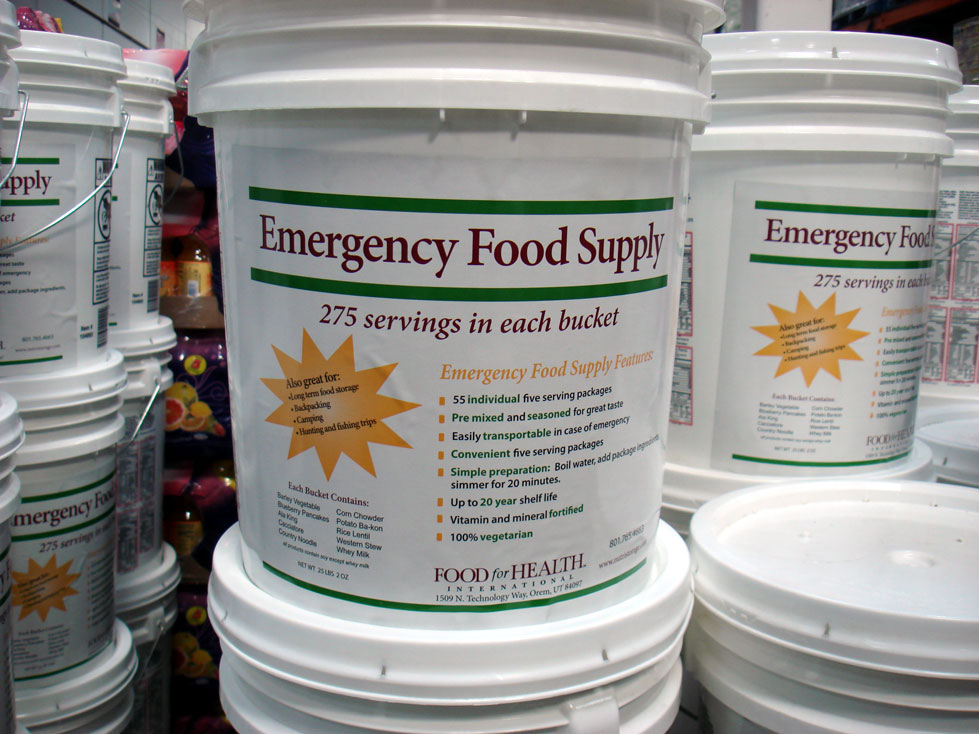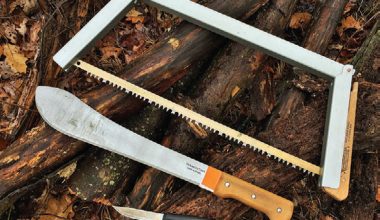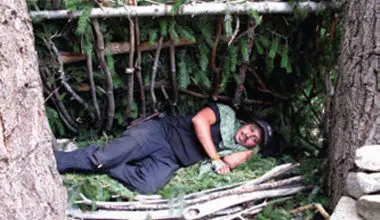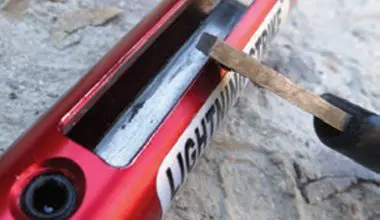Many of us travel frequently. Business trips, family events and vacations, and general day-to-day commuting can place us away from home, community, and our main resources on a regular basis.
And the nightly news is filled with reports of disasters. Whether manmade and occurring in a major city, such as the Boston Marathon bombing, or natural and in a rural area, like last fall’s flooding in Colorado, travelers were caught in the middle of these emergencies. Far from home and their gear, perhaps with no local knowledge, these visitors had to cope with the situation just as locals did. Plan and pack like every day of your trip is going to be sunny and trouble-free, and you’ll be at a disadvantage if something serious goes down. Me—I pack for the worst-case scenario and am ready to take action anywhere.
Whether we are 15 miles away in a neighboring town at work, one state over for a family event, or across the country on a business trip, we can take some precautions so we’re prepared in the event of an emergency or disaster.
Table of Contents
TRAVEL PREPAREDNESS CATEGORIES
I’ve found that breaking travel down into three categories helps me as I pack and plan for emergencies. My categories are business (generally air travel), family (usually ground transportation), and everyday (local car or motorcycle), and I have a standard packing list for each.
While each category has some special considerations, the basics should always be covered.
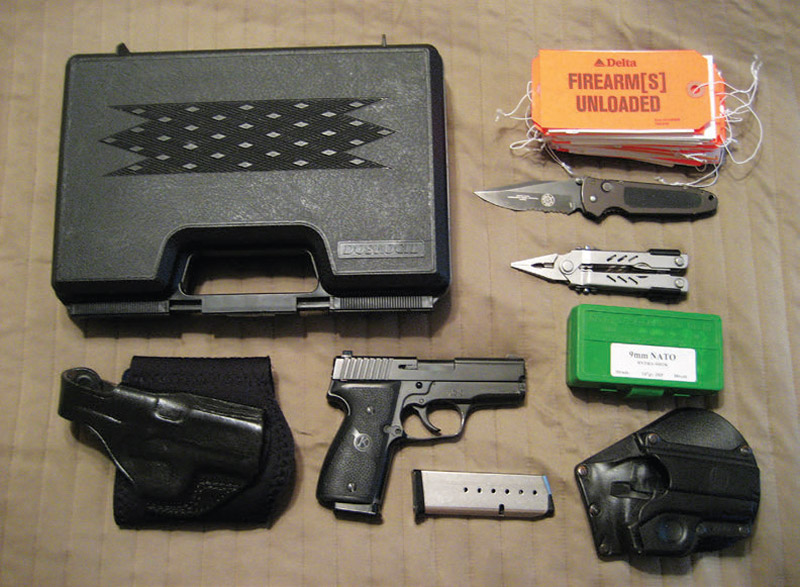
BUSINESS (AIR)
In the course of my professional career, I’ve had the opportunity to travel within the continental United States quite frequently. In fact, I have a stack of 130 airline firearms declarations from the past five years—and I certainly haven’t kept them all. My preferred travel pistols are a Glock 26 or Kahr K9. I prefer to take both an ankle and a belt holster so I can dress up or down depending on the circumstances.
At least one spare mag and extra ammo are mandatory. Traveling with emergency preparedness gear, especially a weapon, takes some pre-planning, thought, and extra time at the airport. With a few airline-approved items in my carryon and the rest of my kit in my checked baggage, I feel much more secure going on an out-of-town business trip.
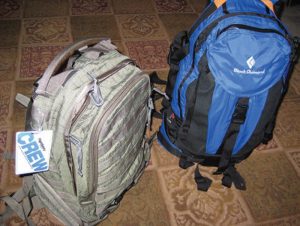
My carry-on items usually consist of a small-to-medium sized backpack and a laptop case. The backpack is carried with an empty hydration bladder to increase my water capability but minimize weight until needed.
Many quality three-day type backpacks are available and can be had in urban camouflage, i.e., commercial-hiking styles and colors, or in more utility/tactical styles and colors. You decide which is most appropriate and fits the environment best. Personally, I see enough of both in airports that I don’t get too concerned about my day-pack profiling me.
My go-to list for a several day long business trip includes the basics of food, clothing and shelter, as well as weapons, flashlights, navigation, and medical supplies. The small Snug- Pak sleeping bags, which can be compressed to a sub-football size, are great for travel. Likewise, the Travel Sack from REI has served me well on many trips. And sleeping with a fleece beanie and clean socks on seems to give me about 10 extra degrees of comfort with these small bags.
Clothing-wise, I have a business suit for work, but arrive at the airport in jeans, a polo or long-sleeved shirt (non-cotton), Gore-Tex mid-height hiking shoes, and a nylon instructorstyle belt. I always have a shell-type rain jacket in my carryon, with a windproof fleece jacket, beanie, and gloves.
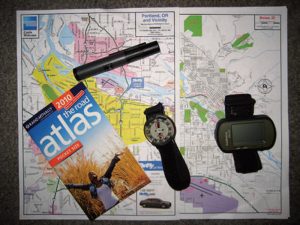
Food in the carry-on usually consists of high-protein, highcalorie snacks (jerky, nuts, energy bars) as well as instant oatmeal and soup and perhaps a freeze-dried entrée. I don’t take anything that can’t be prepared with water.
I include a full set of toiletries in my carry-on bag, plus saline and spare contact lenses.
My carry-on med kit is small, consisting of a few bandaids, an Israeli-type bandage, a tourniquet and some Combat Gauze—better to “have and not need, than to need and not have.” The checked-bag med kit is more comprehensive and includes instruments, needles, injectable meds and sutures.
Other items in my carry-on are 550 cord, butane lighters, a wrist compass, small GPS, Mini Road Atlas (I started carrying one of these as a new flight nurse many years ago and find them very handy), flashlight(s), batteries, hard candy, and 5X monocular. The list goes on and should be limited only by your perceived needs, imagination, and of course FAA regulations.
Even though I always have to check a bag when traveling, and my business associates know to allow extra time if we’re in the same cab or car to get to the airport, the peace of mind that comes with knowing I’m ready for an emergency is worth the hassle.
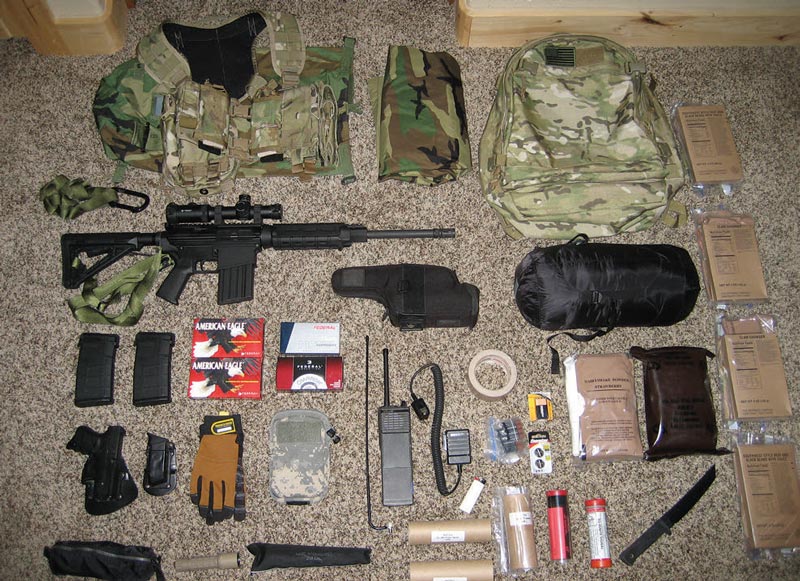
When arriving in a new city, I get the free road map at the car rental facility. Living around prominent mountains most of my life has made me acutely aware of how valuable a solid landmark is to help me stay oriented. The road map or mini atlas helps orient me to local surroundings. Make sure you’re aware of main highways, rivers, hills/mountains, and other features that could be helpful if you end up turned around in your temporary home.
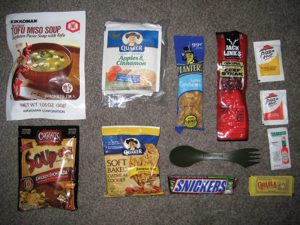
FAMILY (GROUND)
Since most of our family vacations are by ground transport, and I always try to find a place to shoot wherever we go, my travel gear on these trips is much more firearm oriented. I often have some training objective or new piece of gear to wring out, so the trip dedicates a portion of time to that activity.
With that being said, my packing list for these trips goes a little deeper in each category. And with the luxury of more available space, no TSA restrictions, and a tolerant family, I usually bring one or two long guns, more than one pistol, and plenty of support gear. I always pack ammo and supplies for training and fun, as well as a separate supply of designated “social” ammo, just in case.
Everyday carry, on your person—at all times. Do you have a CCW? Do you carry all the time? What about a spare magazine? A light source?
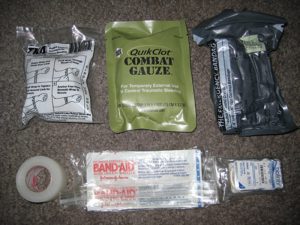
My “leaving the house for any reason” gear includes a Glock 26, spare magazine, auto folding knife, SureFire E2D Executive Defender flashlight, key-ring LED light, multi-tool, and smart phone. If I’m on the Harley, there is a med kit, water, emergency highway blanket, and extra flashlight. The truck is well stocked with food, shelter, inclement weather gear, tools, shovel, etc.
SUMMARY
So there you are, in an unfamiliar city, hundreds of miles away from your home, family, and gear. If a hurricane hits, a snowstorm shuts down all forms of travel, or a terrorist attack occurs, take comfort in knowing you have the gear you need to help you through the event.
Remember the old saying: “Those who fail to prepare are preparing to fail!” Take these ideas as guidelines and tailor them to your personal and family needs. Add a little forethought and a few extra minutes at the airport and you’ll be ready for many of the emergencies that could befall you on your out-of-town adventures.
Stay safe!
